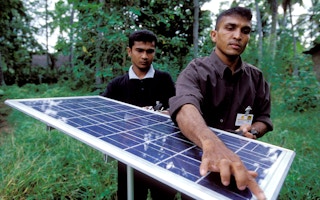Many of us have come to understand that the future of our electricity grids will be “smart.” They will be adaptive systems, embodied by the classical electrical grid but with a variety of modern concepts and technological resources appended.
Smart grids will bring in a new paradigm of active distribution that can dramatically change the role of the consumer and communities, transforming “passive” users into “active” players – both as producers and consumers. The smartest part of this future grid, however, will not be technological but rather human in nature: the “prosumer.”
A prosumer is both a power consumer and producer. Consumers become potential prosumers when they install an energy generation unit such as a solar panel on their premises. As more households, institutions, and businesses set up renewable energy systems, a socio-technica distribution system is emerging. This system is characterised by consumer needs, preferences, and goals, regulations, and the technical requirements of a reliable power supply system.
The technical aspects relate to the equipment and systems that prosumers have at their disposal. First and foremost is a renewable power generation source, often an array of solar panels for small-scale prosumers.
In general, prosumerism is based on distributed energy resources, which can be households or aggregated into communities based on minigrid systems. Essential to the setup are smart meters, which allow two-way communication and power transfer between the prosumer and the energy supplier (now also an energy buyer).
The prosumer may also store electricity in a battery system or an electric vehicle, and is able to control power exports and imports by how he/she uses smart appliances within the home. For instance, prosumers can decide for what periods of time their air conditioning unit may be switched off to reduce consumption and save money. This also helps to manage grid demand.
“
The prosumer is both the end user and the producer. Enabled by technology, the prosumer will be able to make choices around their energy usage that were previously only available to electricity suppliers.
The most important part of prosumerism, though, is its social implication with respect to the emerging distribution system. According to the European Commission Task Force for Smart Grids, it is important at this early stage to understand the role of the prosumer in order for them to successfully assume their new role in the energy transition toward smart grids.
Should prosumers be major stakeholders, or should this responsibility lie at the aggregate (community) level? Should they have direct access to electricity markets? Should prosumer purchases be aggregated, or should the pricing be static?
Prosumers in South Asia
The prosumer movement is gaining traction in South Asia, where several governments are backing grid-connected rooftop solar photovoltaic (PV) programs.
One of the projects in Sri Lanka will encourage consumers to join in power generation by installing small solar power plants on the rooftops of their houses to meet their energy requirements. They can thus generate and use electricity on their premises. If they have a surplus, the prosumers can sell it to the national grid or save it for later use.
Such a scheme is called “net metering”: the net amount of energy created or used by the customer determines whether they must pay the supplier or the supplier must pay them. Net metering, already commonplace around the world, represents the first generation of prosumers.
The Government of India is promoting rooftop solar PV programs for independent power producers at the residential, industrial and institutional levels, to turn consumers into active investors and participants in the energy sector. These schemes include targeted subsidies, like for poor households in Kerala.
The biggest challenge to enabling prosumers to move forward is setting up an effective regulatory environment. This includes developing a pricing methodology that is cost-reflective at all levels of the system, especially distribution networks, promoting low-carbon technologies, and integrating social inclusion considerations such as affordability and access.
The 2nd Lateral Learning Program on Smart Grid Technologies and Implications for Inclusive Development, co-organised last October by ADB and the University of Melbourne’s School of Engineering, concluded that prosumers have an important role to play in “smartening” energy systems in terms of the technical functioning of the system (such as system flexibility) and in relation to cost, environmental, and social inclusion considerations.
Ultimately, the prosumer is both the end user and the producer. Enabled by technology, the prosumer will be able to make choices around their energy usage that were previously only available to electricity suppliers.
With the right policy environment, which is reflective of cost and balances affordability, access, and sustainability, women and marginalised groups can participate as active prosumers in these emerging future energy systems from their inception.
Francesco Tornieri is Principal Social Development Specialist (Gender and Development), South Asia Department at ADB. This post is republished with permission from the ADB blog.


















